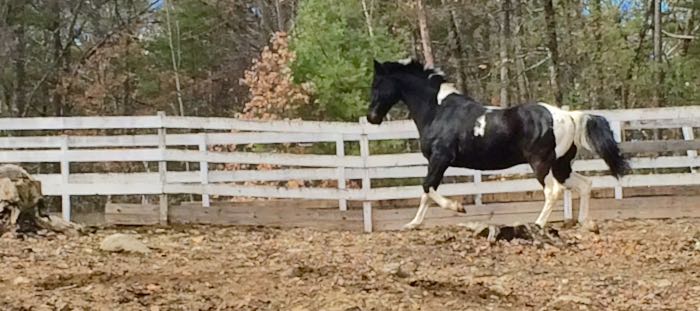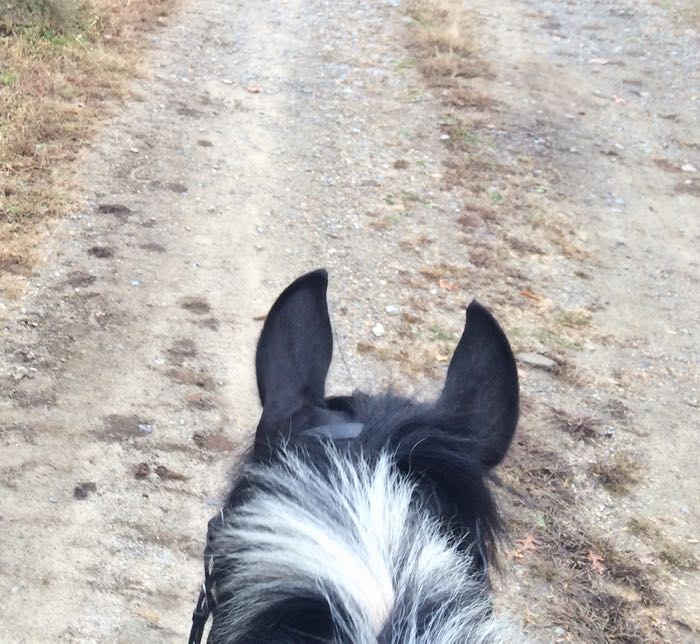Ears are for listening. The horse’s ears swivel in response to sounds both near and far, so if you pay attention to the ears, your world opens up. My horse hears far better than I do, so by watching his ears I see things that I would otherwise not have noticed. I recently followed Tonka’s ears and saw a person far off the trail in the woods. Because Tonka let me know that there was someone there, as the hiker emerged from the trees later, neither of us were startled (although the hiker was!)
Ears also communicate a horse’s mood. Here is Tonka, relaxed after a warm up and ready to enter the dressage ring.
Sometimes ears can be an early warning system for the rider. Horses are large, and to us humans, mythic animals. We think of them in dramatic poses – galloping across plains, rearing up, neighing loudly. Yet in their personal lives horses prefer to communicate with subtlety. They never yell if they can get their point across in a nuanced way. Unfortunately for our horses, we’re often oblivious to what they’re saying until they have to escalate to dangerous behavior. I’ve written about how to read a horse’s ear position here.
Tonka has only bucked a few times while I’m on his back, but they were doozies. (It felt rather like this.) I’m an experienced enough rider to sense when something is about to happen – the ears pin back, the horse’s body bunches, and then his legs do a sproingy step right before the imminent eruption. That said, those warning signs can take only three seconds which is not enough time to convince the horse to do something other than leap with all four off the ground. (It’s enough, though, for me to sit tight and not come off!) A big buck can seem like out of the blue behavior, but it’s not. There are always antecedents to the acrobatics. The first buck that Tonka threw happened when we were behind another horse on a trail. Tonka likes to amble and the horse in front was moving along at a faster clip. Tonka would lag and then trot to catch up. I didn’t want him to do that, and in an attempt to get a more energetic walk, I held him back from trotting. Tonka was annoyed and he let me know it.
At the time I did notice the pinned ears and the tensing body. But it took another buck before I noticed an odd warning sign. Right before he let loose, Tonka twitched his head and flicked his ears as if there were bees buzzing around him. Nothing frantic, just a head shake. Since then, I’ve seen Tonka do this a dozen times, and in each instance it’s a clear tell that he’s overwhelmed. That ear flick is the equivalent of him saying, Terry, I’ve had it. This is too much!
Along with trail riding, I also do dressage. In dressage competitions, you ride patterns in a rectangular ring. Dressage builds up to balanced, cadenced, seemingly floating movement. This can (and should) take years. It’s like a figure skater going from wobbling on a blade to leaping double axels. We’re in the early stages, but we’ve recently had a breakthrough to the next level. Tonka is now able to push off more from his hindquarters and lift his forehand as he goes. He’s getting lots of rewards (mints and praise) for his hard work, and he seems to enjoy it – he’s going with a relaxed back and happy ears. But yesterday, as he gathered himself to go into this frame, I saw that head shake. If it was fly season I might have written it off as something buzzing about, but there are no annoying insects in March. The work was irritating him. The rest of Tonka’s body was doing as I asked, but I saw the tell. Good training builds on successes, it doesn’t push past a physical or mental limit and then punish failure. I want cooperative, enthusiastic engagement, not forced behavior. So, I respect what those ears have to say.
I don’t know what at that moment bothered Tonka. Last week the horses got their spring vaccines. Maybe he was sore. Maybe there was a twinge in his hocks. Maybe the movement felt like work and not joy. Whatever. I took a deep breath, relaxed, and ratcheted back to a basic, swinging. long-necked trot. Sometimes the slower you go, the faster you get there.

Here is Tonka later that day. All of the horses “had the wind under their tails” and were snorting it up around the paddocks. He’s carrying himself in a way that we’re working towards under saddle. Even at liberty, this is physically demanding and he only sustains it for a dozen strides.



Great blog on Tonga, the cartoon really made me giggle. Do you wear safety glasses when riding ?
Slow is always fast. It keeps you from having to go back to the beginning and start over with possible bad habits attached.
And, Hey!, it’s March Madness! It’s a little late down here, but the critters around here are bouncing around and being jumpy and goofy and sometimes testy. Captain Oblivious (my husband) was losing it a couple of days ago. “What is WRONG with these animals!?” (Four cats and a dog at our house right now.) I just smiled sweetly and asked what month it was. I won’t print his response. :D
And what a wonderful picture you managed to get of Tonka! That one’s definitely a keeper!
They’ve all gone bonkers at Tonka’s barn, too.
Great article on Tonka. And you. For my equine dressage partner of many years, the “tell” was excessive jaw movement and “bit worrying”. She was telling me she was overwhelmed, or bored, or sore, or unhappy. And every time I was smart enough to catch it, I would take my childhood coach’s advice and immediately “apologize to my mare”, slow to a walk and release the reins, class over. Her head and neck would stretttttch out and drop, her beautiful, long and very active walk would resume and her ears and jaw would relax. Weather permitting, I would often unsaddle her and take her down to a little creek where she could roll in the foot deep, ice cold water and soft sand bar, before turning her out to gallop around like a filly before finding the filthiest spot possible to “dry off”.
The gorgeous shot of Tonka at liberty reminded me that as my coaches would say, “if you’re lucky enough to own a horse capable of such beautiful action, it’s all up to you to remove whatever inhibitors are in their way. Just get out of your mare’s way, Tracy.” Riding is so humbling, isn’t it?
And the Thelwell ponies always remind me of the tiny, jet black Boo Boo, a little Chincoteague pony I brought home in the back of a station wagon and who was such a character. Boo Boo lived to be 32 and was as sound as a dollar until he died. At his most extended trot, I think his length of stride was about…a foot. :)
It’s a good sort of humbling.
You certainly had an equine heaven – a cold, sandy stream? Ahhh.
The property was a former dairy farm and I bought it for the land and barns, although the quirky 1886 house was lovely, as well. The main pasture was 28 acres and had six huge trees providing shade and a clean, spring fed, seasonal creek. Six other, smaller paddocks were also securely fenced with shade and run ins, which had been used for sorting, working and weaning the cattle. The farmer who had owned it prior had been there for 41 years, following his father, and grandfather, and had worked on the quality of the grass every year, something I learned to do, as well. When I bought it, he kindly advised me on how to convert the long dairy barn into modular horse stalls, adjustable from 12′ X 12′ to 12′ X 20′, important for some of those high strung ex-racers. He had done everything right, buried all the water pipes five feet deep, dug an extra deep well, laid a sub bed of crowned clay under all the gravel drives and roads so they never shifted, drained well, etc.
I never ceased to be amazed at how wise these old farmers were when they created their homesteads. Even the barn was sited so carefully that a strong breeze ran down the main aisle all summer, and none in winter. Everything was over built, and the engineering was so simple, but genius. Even the hay loft had brilliant updraft air circulation with four spinning cupolas he and his son had built themselves that could be locked shut in winter to conserve heat. He gave me such great advice over the years: “paint every inch of your fencing every single year and it will last forever.” He was right. “Hire a local pack of Jack Russells to clear your pasture of woodchucks and gophers every summer and you’ll save your horses’ legs.” I did, and he was right. “Be sure to have your neighbors over several times a year for dinner and they’ll forgive you when a loose horse (or that damn Boo Boo) eats their herb garden.” I did, and invited him and his wife. “Build a good relationship with the best local vet and give their kids free riding lessons. It will matter at 4 a.m. when colic strikes or somebody needs stiches and it’s four degrees.” I had the same vet for 25 years and I’d come home to find him warming up in my kitchen with a cup of tea he’d made himself. “Treat your farrier like the professional he is and make sure he has a secure spot to work in, a sandwich, a cold drink and a reliable kid to be his assistant.” I did, and the kids loved it.
I learned so much from him, from that beautiful place and from all the magnificent horses and naughty ponies who walked through it. I eventually sold it to two brothers in their 30s who farm the once-paddocks organically, using draft horses for field work and raising some goats, as well. Those big drafts still enjoy the big pasture, good grass, and ice cold stream. I hold their mortgage; they’ve never missed a payment, and many are hand delivered tucked into a large box of fresh produce.
You lucky, lucky person. What a wonderful place and life, you have been blessed.
You’ve just described how purpose + deep care = beauty. How wonderful that you’ve been a steward of this good place in the world. It might be a small dot on the planet, but it matters. Kindness ripples out.
I remember the first time I ever got bucked off a horse.
To my credit, I got right back on…well, I did after I begged another quarter from my mom.
We all have to start somewhere :)
I’ve adored Thelwell’s work since a child. They always make me smile.
Another thing I’ve noticed will set animals off is a lot of wind, something we’ve had all too much of this end of March. I thought March went out like a lamb!
I was thinking the same about the lion/lamb thing! Snow is predicted for Sunday.
It’s truly fascinating to hear how you have worked with Tonka. I have no background with horses, so each post is a learning experience for me.
Each day with him is a learning experience for me, too :)
Oye! I agree that the wind has been quite a disturbance in “the force!” Here in Illinois, as in many states now it seems, the weather has been bipolar! I “sit” for a rescued Arabian, who is at turns excited by the wind and frightened by it. Oh, the smells she must smell blowing in from every direction! I watch her stand and suck in the air with her nostrils opened as big as she can open them, interpreting what she smells. I could watch her for hours. They are truly mystical, lovely animals. I secretly wish she could talk to me!
She is talking to you, but like learning all foreign languages, it takes years of study :)
That second photo is so beautiful. You are both dressed in immaculate black and whites and after a lifetime in catering I know about that, but ours are not any thing like as beautiful as that photo. l love learning more about horses and their ways of communicating from you.
I used to be taken riding as a child by my aunt and loved it but haven’t ridden as an adult. There is so much more to it than I could ever have imagined back then. I just loved the feeling of being close to these wonderful animals and now it lives on in me through you. Thank you Terry.
I’m happy to share him virtually through my blog.